
The Indian economy is much more resilient to external shocks now than was last year, a top IMF official has said, attributing this to a series of administrative decisions and policy measures taken by the Union Government.
"We see India much more resilient than they were about the middle of last year to external shocks,” Paul Cashin, the International Monetary Fund Assistant Director of the Asia and Pacific Department told reporters during a conference call.
"In recent months, India has taken very substantial measures to narrow both its external and fiscal imbalances, tighten monetary policy, move forward on structural reforms, and address aspects of this market volatility," Cashin said in response to a question during the call.
. . .

"The authorities have met their fiscal target for this fiscal year.
"Investment project approvals are accelerating, and they're beginning to tackle the inflation issue by tightening the monetary stance," Cashin said.
He said all these developments ‘certainly make India more resilient to any external shocks that may be coming along’.
Briefing reporters on the results of the annual IMF consultations with India, Cashin said growth has slowed significantly in India, chiefly because of the structural bottlenecks and weaknesses in investment.
It will take a period of time to recover back to the higher levels that India enjoyed in previous years, he said.
. . .

Joining the conference call from New Delhi, Thomas Richardson, IMF's Senior Resident Representative, said India’s financial system is fundamentally sound.
Responding to questions, Cashin argued there is no reason why India should not go back to 8-9 per cent growth rate.
"Traditionally India has grown at 7, 8, 9 per cent, and we see no reasons why it can't go back to those sorts of levels if some of the bottlenecks and structural reforms are introduced, which is presently holding back India's growth path," he said.
Setting the agenda for the next government to be formed after the general elections, Richardson on Thursday also emphasised on the need to focus on power generation, mining reforms in terms of pricing of natural resources as well; and better revenue.
. . .

"We think there are some structural things that they can do that would be growth positive, growth enhancing while also improving India's sustainability, reduced vulnerability, and so forth," Richardson said and called for reducing unproductive subsidies.
"One way that India can better target subsidies, not only fuel subsidies, but also food subsidies, is by moving forward with direct cash transfers linked to the unique identification system, that so called Aadhaar, that the government is pushing forward," he said.